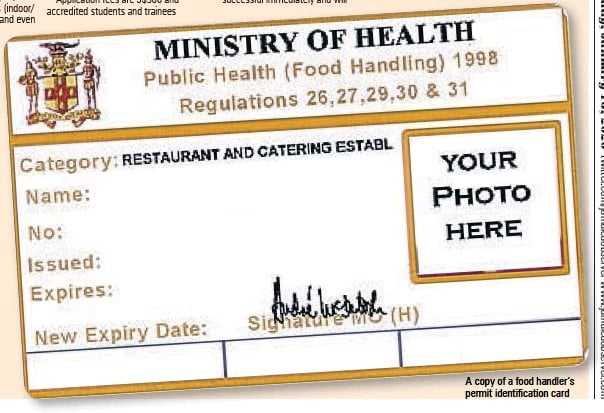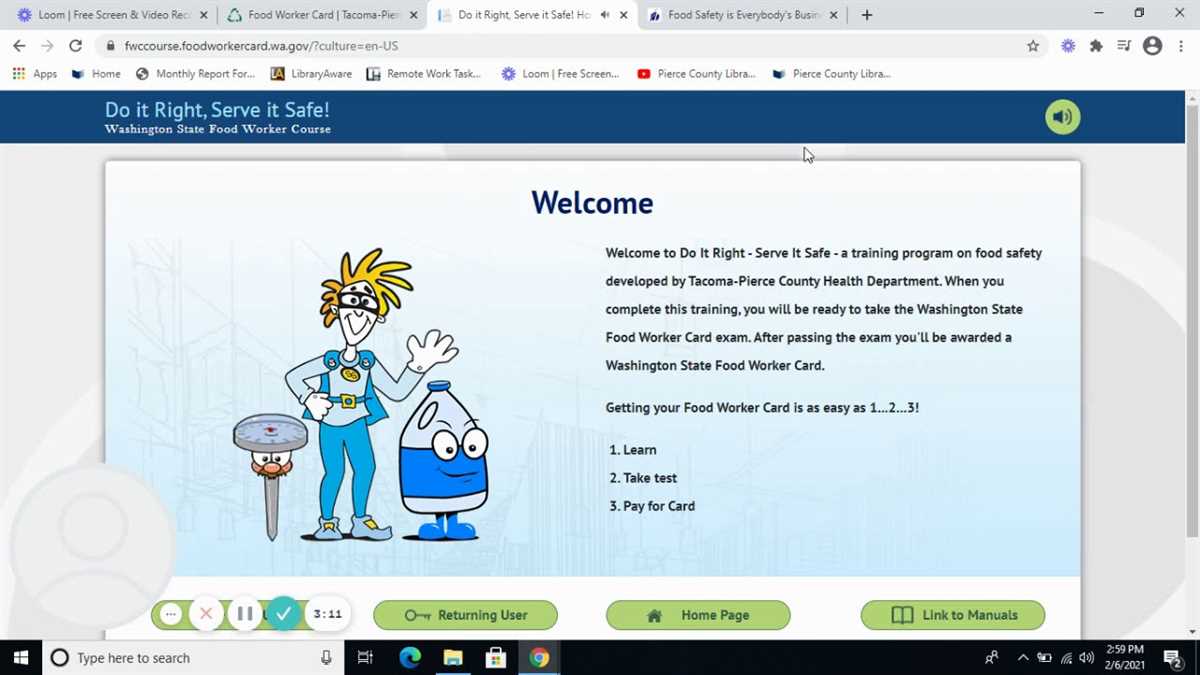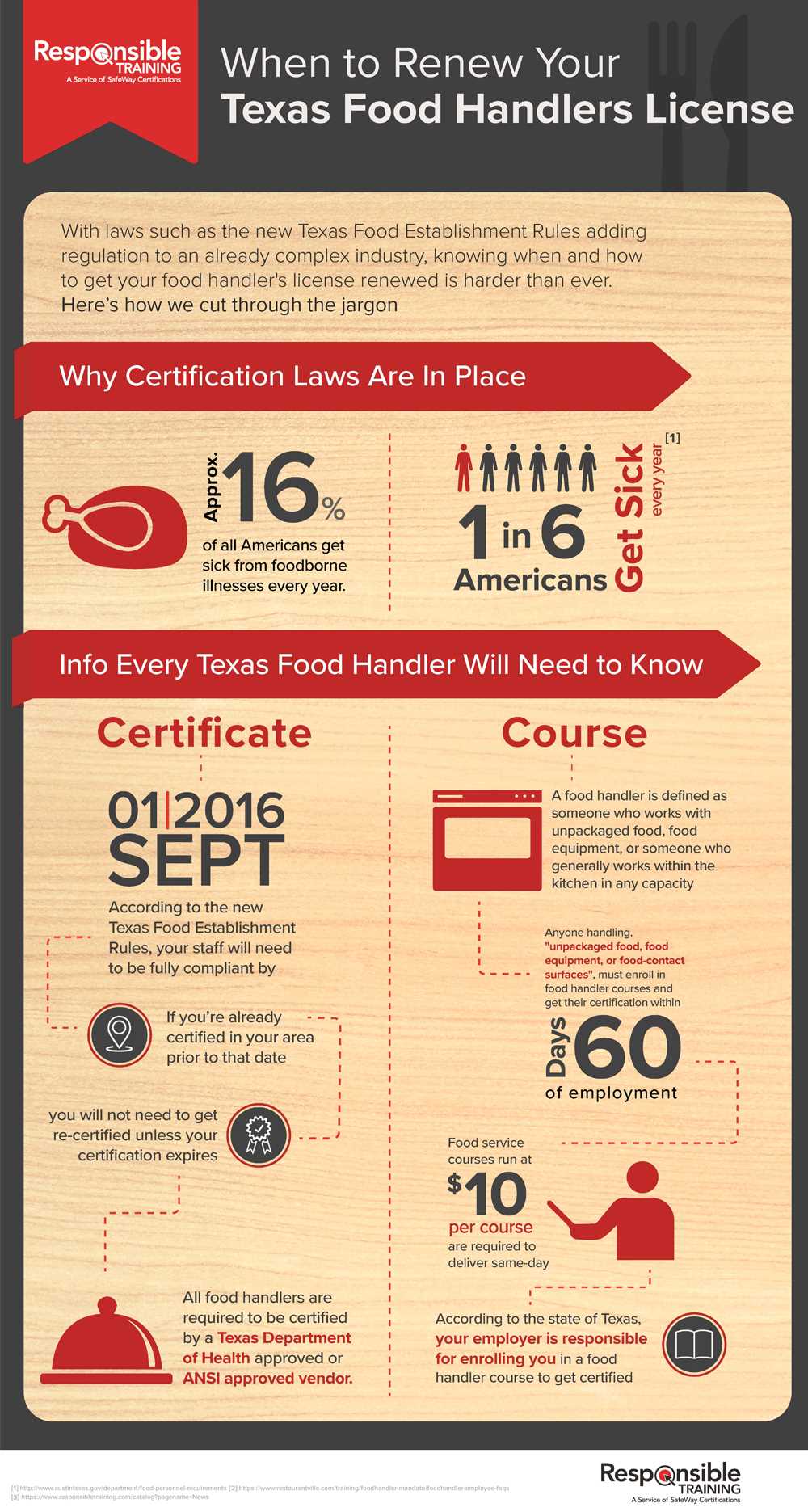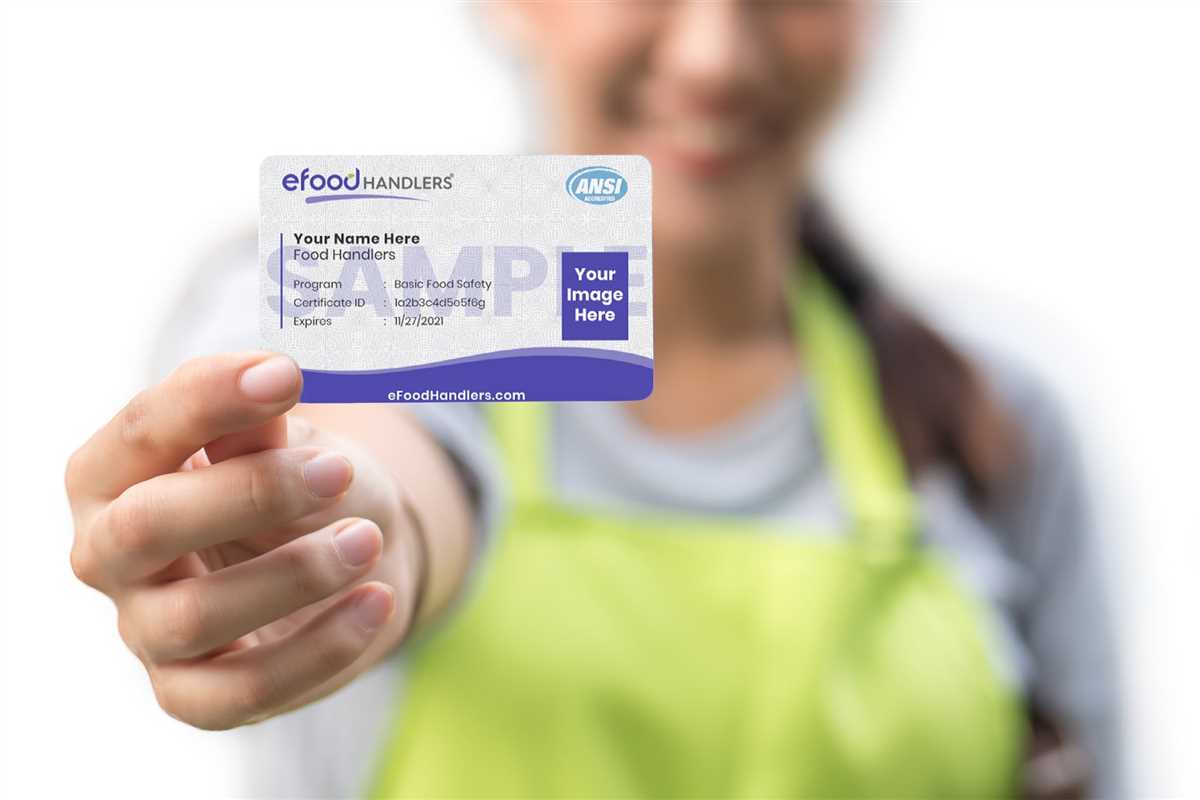
Obtaining a food handlers card is a crucial step for anyone working in the food industry. It ensures that individuals have the necessary knowledge and skills to handle food safely and maintain high standards of hygiene. The test to acquire this card can be challenging, as it covers various topics related to food safety and handling.
Knowing the correct answers to the food handlers card test is essential to pass the examination. It requires a comprehensive understanding of topics such as personal hygiene, proper food storage, temperature control, cross-contamination prevention, and cleaning and sanitizing practices. By mastering these concepts and their corresponding answers, individuals can confidently ace the test and demonstrate their commitment to providing safe and high-quality food to consumers.
Studying and familiarizing oneself with the food handlers card test answers is not only beneficial for passing the exam but also for ensuring the overall safety of food establishments. With the proper knowledge, food handlers can effectively prevent foodborne illnesses and maintain a hygienic environment in the kitchen. These answers serve as a guide and reference to handle various situations that may arise during food preparation and service, promoting best practices and reducing the risk of food contamination.
Food Handlers Card Test Answers
Obtaining a food handlers card is essential for anyone working in the food industry. It ensures that individuals have the knowledge and skills necessary to handle and prepare food safely. To pass the food handlers card test, one must be familiar with different topics related to food safety and handling. Here are some common questions and answers that you may encounter on the test:
1. What is the correct temperature for storing raw meat?
The correct temperature for storing raw meat is below 41°F (5°C). This helps prevent the growth of bacteria that can cause foodborne illnesses.
2. What is the danger zone?

The danger zone refers to the temperature range between 41°F (5°C) and 135°F (57°C). Within this range, bacteria multiply rapidly, increasing the risk of foodborne illness. It is important to keep hot foods hot (above 135°F) and cold foods cold (below 41°F) to avoid the danger zone.
3. How often should you wash your hands?

You should wash your hands before starting work, after using the restroom, after handling raw meat or poultry, after touching your face or hair, and after any other activity that may contaminate your hands. Handwashing is crucial in preventing the spread of bacteria and viruses.
4. What is cross-contamination?

Cross-contamination occurs when bacteria or other microorganisms are transferred from one food or surface to another. This can happen through contact with raw meat, inadequate handwashing, using the same cutting board or utensils without cleaning them properly, or storing cooked and raw foods together. It is important to prevent cross-contamination to ensure food safety.
5. How long can leftovers be safely stored in the refrigerator?
Leftovers can be safely stored in the refrigerator for up to four days. After that, they should be discarded to prevent the risk of foodborne illness. It is important to label and date leftovers to keep track of their freshness.
What is a food handlers card?

A food handlers card, also known as a food safety certification, is a document that certifies that individuals working in the food service industry have received training and demonstrated knowledge of proper food handling practices. This certification is typically required by local health departments and regulatory agencies to ensure that food service establishments maintain a safe and hygienic environment.
To obtain a food handlers card, individuals must typically complete a food safety training course that covers topics such as personal hygiene, cross-contamination prevention, safe food storage, proper cooking temperatures, and foodborne illness prevention. The course may be completed online or in a classroom setting, and usually concludes with an exam.
Once an individual successfully completes the training course and passes the exam, they are issued a food handlers card, which is valid for a specific period of time, usually 2-3 years. The card must be visibly displayed at the individual’s place of work to demonstrate compliance with food safety regulations.
A food handlers card not only ensures that individuals have the necessary knowledge to handle food safely, but also helps to protect the health and safety of consumers. It is an essential requirement for anyone working in the food service industry, including chefs, cooks, servers, and food preparation staff. By obtaining a food handlers card, workers can demonstrate their commitment to maintaining a clean and safe working environment, and provide consumers with peace of mind when eating out.
Why is a food handlers card important?
The food handlers card, also known as the food safety certificate, is an essential requirement for anyone working in the food service or hospitality industry. It is a document that demonstrates that an individual has completed a training program on food safety and has passed an exam to prove their knowledge and understanding of safe food handling practices.
One of the main reasons why a food handlers card is important is that it helps to ensure the safety and well-being of consumers. By requiring food handlers to obtain this certification, it helps to minimize the risk of foodborne illnesses and outbreaks. The training program covers topics such as proper food storage, hygiene practices, cross-contamination prevention, and temperature control, which are all crucial in preventing the spread of pathogens and maintaining food safety standards.
- Legal Compliance: Possessing a food handlers card is often a legal requirement in many jurisdictions. Food establishments are typically subjected to regular inspections by health authorities, and failure to comply with food safety regulations can result in fines, closure of the establishment, or even legal action. By obtaining a food handlers card, individuals can ensure that they are in compliance with the law and avoid any potential legal consequences.
- Employment Opportunity: Many employers in the food service industry require their staff to have a food handlers card as a condition of employment. This certification demonstrates an individual’s commitment to food safety and their ability to follow proper procedures, making them more desirable candidates for job opportunities. By obtaining a food handlers card, individuals can enhance their employment prospects and open doors to a wider range of career opportunities.
- Professional Development: The process of obtaining a food handlers card involves completing a training program and passing an exam. This educational experience helps individuals broaden their knowledge and skills in food safety. The information learned during the training program can be applied not only in the workplace but also in everyday life. It equips individuals with the necessary knowledge to handle food safely, whether they are cooking at home or dining out at restaurants.
In conclusion, a food handlers card is an important document that ensures the safety of consumers, helps with legal compliance, enhances employment opportunities, and promotes professional development. By obtaining this certification, individuals demonstrate their competence in food safety practices and contribute to maintaining a high standard of food hygiene in the industry.
How to obtain a food handlers card?
Obtaining a food handlers card is an important step for anyone working in the food industry. This certification demonstrates that an individual has the necessary knowledge and skills to handle and prepare food safely, minimizing the risk of foodborne illnesses. Here are the steps to obtain a food handlers card:
1. Training: First, individuals need to complete a food handlers training course. These courses are typically offered by local health departments or online platforms. The training covers topics such as proper food handling techniques, personal hygiene, preventing cross-contamination, and understanding food allergies.
- a. In-person training: Some health departments offer in-person training sessions where individuals can attend classes and receive hands-on instruction. These sessions may include demonstrations, group activities, and discussions to enhance learning.
- b. Online training: Many online platforms offer food handlers training courses that can be completed at the learner’s own pace. These courses often include interactive modules, quizzes, and videos to facilitate learning.
2. Study and review: After completing the training, individuals should review the course material to ensure they have a solid understanding of the topics covered. This may involve revisiting the modules, reviewing notes, and taking additional practice quizzes if available.
3. Take the exam: The next step is to take the food handlers exam. This exam assesses the individual’s knowledge and understanding of food safety principles and practices. It may be administered online or in person, depending on the certification provider. The exam typically consists of multiple-choice questions, and individuals need to achieve a passing score to obtain their food handlers card.
4. Obtain the food handlers card: Once the exam is successfully completed, individuals will receive their food handlers card. This card serves as proof that they have met the necessary requirements to handle food safely. It is important to keep the card in a safe place and present it to employers or health inspectors when required.
5. Renewal: Food handlers cards usually have an expiration date, typically valid for a few years. Individuals need to renew their card before it expires to ensure they stay up to date with the latest food safety practices. Renewal may involve completing a refresher course or retaking the exam.
In conclusion, obtaining a food handlers card involves completing a training course, reviewing the material, taking an exam, and receiving the card as proof of certification. This card is important for anyone working in the food industry to ensure the safe handling and preparation of food.
What does the food handlers test consist of?
The food handlers test is a comprehensive examination that assesses the knowledge and skills of individuals who work with food in various capacities. It is designed to ensure that food handlers have a thorough understanding of food safety practices and can effectively implement them in their daily work routine.
The test typically consists of multiple-choice questions that cover a wide range of topics related to food safety and handling. These may include questions on proper food storage and handling, personal hygiene, cross-contamination prevention, temperature control, and sanitation procedures.
Food handlers are also evaluated on their understanding of specific regulations and guidelines set by local health departments or industry organizations. This may include knowledge of foodborne illnesses, allergen management, and the proper use of cleaning agents and equipment.
To pass the food handlers test, individuals must demonstrate a solid understanding of these topics and be able to apply the principles effectively in a real-world setting. The test is typically administered online or in-person, and a passing score is required to receive a food handlers card or certification.
In addition to the written test, some jurisdictions may also require food handlers to complete a practical demonstration of their skills, such as proper handwashing or correct glove usage. This ensures that individuals not only have the knowledge but also the practical skills necessary to handle food safely.
Overall, the food handlers test is an essential component in ensuring the safety and well-being of consumers. By evaluating the knowledge and abilities of food handlers, it helps to minimize the risk of foodborne illnesses and maintain a high standard of food safety in the industry.
How long is the food handlers card valid?
The food handlers card, also known as a food safety certificate or food handler permit, is a document that certifies that an individual has completed a food safety training course and has demonstrated knowledge of safe food handling practices. It is commonly required for individuals working in the food service industry, such as restaurant employees or food truck operators.
The validity period for a food handlers card varies depending on the jurisdiction and the specific regulations in place. In some areas, the card is valid for a certain number of years, such as three or five years, while in other areas, it may need to be renewed annually. It is important for food handlers to be aware of the expiration date on their card and to renew it in a timely manner to remain compliant with local regulations.
In addition to knowing the validity period of the food handlers card, it is also important for food handlers to understand the requirements for renewal. This may involve completing a refresher training course or passing a renewal exam to demonstrate ongoing knowledge and understanding of safe food handling practices. By staying up to date with their food handlers card, individuals can help ensure the safety and well-being of both themselves and the customers they serve.
Can the test be retaken if failed?

If you fail the food handlers card test, don’t worry, you will have the opportunity to retake it. The exact requirements and procedures for retaking the test may vary depending on the state or local jurisdiction where you are obtaining your food handlers card. It is important to consult the specific guidelines provided by the issuing authority to understand the retake process.
In some cases, you may be allowed to retake the test immediately after receiving your results. This means that if you didn’t pass on the first attempt, you will have another chance to answer the questions correctly and demonstrate your knowledge of food safety practices. However, this immediate retake option may come with certain restrictions, such as a limited number of retakes allowed within a specified timeframe.
Alternatively, the issuing authority may require you to wait for a specific period of time before retaking the test. This waiting period allows you to further study and review the necessary material to increase your chances of passing the exam. It is important to take advantage of this time and utilize resources such as study guides or online courses to improve your understanding of food safety principles.
Remember, failing the food handlers card test does not mean that you are incapable of working in the food service industry. It simply indicates that there are areas of knowledge that need improvement. By taking the opportunity to retake the test, you can enhance your understanding of food safety practices and ultimately earn your food handlers card.